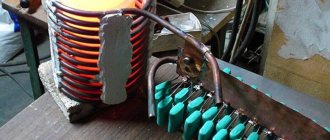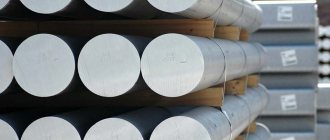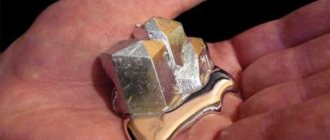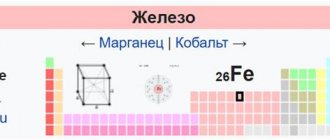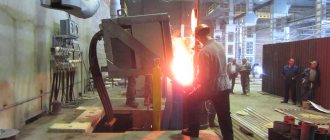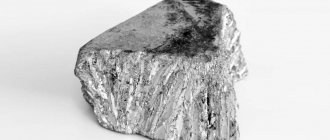| aluminum | |
| Atomic number | 13 |
| Appearance of a simple substance | soft light metal silver-white color |
| Properties of the atom | |
| Atomic mass (molar mass) | 26.981539 a. e.m. (/mol) |
| Atomic radius | 143 |
| Ionization energy (first electron) | 577.2(5.98) kJ/mol () |
| Electronic configuration | [Ne] 3s2 3p1 |
| Chemical properties | |
| Covalent radius | 118 |
| Ion radius | 51 (+3e) |
| Electronegativity (Pauling) | 1,61 |
| Electrode potential | -1.66 V |
| Oxidation states | 3 |
| Thermodynamic properties of a simple substance | |
| Density | 2,6989 /³ |
| Molar heat capacity | 24.35[1]/(mol) |
| Thermal conductivity | 237 /(·) |
| Melting temperature | 933,5 |
| Heat of Melting | 10.75 kJ/mol |
| Boiling temperature | 2792 |
| Heat of vaporization | 284.1 kJ/mol |
| Molar volume | 10.0 ³/mol |
| Crystal lattice of a simple substance | |
| Lattice structure | cubic face-centered |
| Lattice parameters | 4,050 |
| c/a ratio | — |
| Debye temperature | 394 |
| Al | 13 |
| 26,981539 | |
| [Ne]3s23p1 | |
| Aluminum | |
Aluminum
- an element of the main subgroup of the third group of the third period of the periodic system of chemical elements of D.I. Mendeleev, atomic number 13. Denoted by the symbol Al (Aluminium). Belongs to the group of light metals. The most common metal and the third most abundant (after oxygen and silicon) chemical element in the earth's crust. The simple substance aluminum (CAS number: 7429-90-5) is a lightweight, paramagnetic silver-white metal that can be easily formed, cast, and machined. Aluminum has high thermal and electrical conductivity and resistance to corrosion due to the rapid formation of strong oxide films that protect the surface from further interaction. According to some biological studies, the intake of aluminum in the human body was considered a factor in the development of Alzheimer's disease, but these studies were later criticized and the conclusion about the connection between one and the other was refuted.
Receipt
The modern production method was developed independently by the American Charles Hall and the Frenchman Paul Héroult. It consists of dissolving aluminum oxide Al2O3 in a melt of cryolite Na3AlF6, followed by electrolysis using graphite electrodes. This production method requires a lot of electricity, and therefore became popular only in the 20th century.
To produce 1 ton of crude aluminum, 1.920 tons of alumina, 0.065 tons of cryolite, 0.035 tons of aluminum fluoride, 0.600 tons of anode mass and 17 thousand kWh of DC electricity are required.
Metal density indicator
The density parameter of any substance is calculated as the ratio of mass to volume and measured in g/cm³. Using this indicator for arithmetic calculations allows you to determine the weight of workpieces or products.
Often, to estimate the amount of material per unit volume, the specific gravity indicator is used, which, unlike density, has only a quantitative characteristic.
Aluminum, whose density is 2712 kg/m3, is the most popular material for various industrial sectors. Due to its special physical and chemical characteristics, the metal is used as a alloy component of an alloy with gold.
The melting point is 660 °C. Metal boils at a temperature of 2519 °C. The density of liquid metal is 2560-2640 kg/m3, in the solid state the figure is 2712 kg/m3. Molten chemically pure metal at a temperature of 660 °C has a density of 2.368 g/cm³, and at 1173 °C - 2.304 g/cm³.
Aluminum has high thermal conductivity, which is taken into account along with the physical parameters of the composition. The density of aluminum alloys differs slightly from the density for pure metal.
Physical properties
The metal is silver-white in color, light, density - 2.7 g/cm³, melting point for technical aluminum - 658 °C, for high-purity aluminum - 660 °C, specific heat of fusion - 390 kJ/kg, boiling point - 2500 ° C, specific heat of evaporation - 10.53 MJ/kg, temporary resistance of cast aluminum - 10-12 kg/mm², deformable - 18-25 kg/mm², alloys - 38-42 kg/mm².
Brinell hardness is 24-32 kgf/mm², high ductility: technical - 35%, pure - 50%, rolled into thin sheets and even foil.
Aluminum has high electrical and thermal conductivity, 65% of the electrical conductivity of copper, and has high light reflectivity.
Aluminum forms alloys with almost all metals.
Melting point table
It is important for any person associated with the metallurgical industry, be it a welder, foundry worker, smelter or jeweler, to know the temperatures at which the materials he works with melt. The table below shows the melting points of more common substances.
Table of melting temperatures of metals and alloys
| Title | T pl, °C |
| Aluminum | 660,4 |
| Copper | 1084,5 |
| Tin | 231,9 |
| Zinc | 419,5 |
| Tungsten | 3420 |
| Nickel | 1455 |
| Silver | 960 |
| Gold | 1064,4 |
| Platinum | 1768 |
| Titanium | 1668 |
| Duralumin | 650 |
| Carbon steel | 1100−1500 |
| Cast iron | 1110−1400 |
| Iron | 1539 |
| Mercury | -38,9 |
| Cupronickel | 1170 |
| Zirconium | 3530 |
| Silicon | 1414 |
| Nichrome | 1400 |
| Bismuth | 271,4 |
| Germanium | 938,2 |
| Tin | 1300−1500 |
| Bronze | 930−1140 |
| Cobalt | 1494 |
| Potassium | 63 |
| Sodium | 93,8 |
| Brass | 1000 |
| Magnesium | 650 |
| Manganese | 1246 |
| Chromium | 2130 |
| Molybdenum | 2890 |
| Lead | 327,4 |
| Beryllium | 1287 |
| Will overcome | 3150 |
| Fechral | 1460 |
| Antimony | 630,6 |
| titanium carbide | 3150 |
| zirconium carbide | 3530 |
| Gallium | 29,76 |
In addition to the melting table, there are many other auxiliary materials. For example, the answer to the question, what is the boiling point of iron lies in the table of boiling substances. In addition to boiling, metals have a number of other physical parameters, such as strength.
Being in nature
Natural aluminum consists almost entirely of a single stable isotope, 27Al, with traces of 26Al, a radioactive isotope with a half-life of 720 thousand years, formed in the atmosphere when bombarded by argon
cosmic ray protons.
In terms of prevalence in nature, it ranks 1st among metals and 3rd among elements, second only to oxygen and silicon. The percentage of aluminum content in the earth's crust, according to various researchers, ranges from 7.45 to 8.14% of the mass of the earth's crust.
In nature, aluminum is found only in compounds (minerals). Some of them:
- Bauxite - Al2O3 • H2O (with admixtures of SiO2, Fe2O3, CaCO3)
- Nephelines - KNa3[AlSiO4]4
- Alunites - KAl(SO4)2 • 2Al(OH)3
- Alumina (mixtures of kaolins with sand SiO2, limestone CaCO3, magnesite MgCO3)
- Corundum - Al2O3
- Feldspar (orthoclase) – K2O×Al2O3×6SiO2
- Kaolinite – Al2O3×2SiO2 × 2H2O
- Alunite - (Na,K)2SO4×Al2(SO4)3×4Al(OH)3
- Beryl - 3BeO • Al2O3 • 6SiO2
Natural waters contain aluminum in the form of low-toxic chemical compounds, for example, aluminum fluoride. The type of cation or anion depends, first of all, on the acidity of the aqueous medium. Aluminum concentrations in surface water bodies in Russia range from 0.001 to 10 mg/l.
Aluminum salts
Aluminum nitrate and sulfate
When heated, aluminum nitrate decomposes into aluminum oxide, nitrogen oxide (IV) and oxygen:
4Al(NO3)3 → 2Al2O3 + 12NO2 + 3O2
Aluminum sulfate, when heated strongly, decomposes in a similar way - into aluminum oxide, sulfur dioxide and oxygen:
2Al2(SO4)3 → 2Al2O3 + 6SO2 + 3O2
Complex aluminum salts
To describe the properties of complex aluminum salts - hydroxyaluminates, it is convenient to use the following technique: mentally break tetrahydroxoaluminate into two separate molecules - aluminum hydroxide and alkali metal hydroxide.
For example, we break sodium tetrahydroxyaluminate into aluminum hydroxide and sodium hydroxide:
We break Na[Al(OH)4] into NaOH and Al(OH)3
The properties of the entire complex can be determined as the properties of these individual compounds.
Thus, aluminum hydroxo complexes react with acidic oxides.
For example, the hydroxo complex is destroyed by excess carbon dioxide. In this case, NaOH reacts with CO2 to form an acid salt (with an excess of CO2), and amphoteric aluminum hydroxide does not react with carbon dioxide, therefore, it simply precipitates:
Na[Al(OH)4] + CO2 → Al(OH)3↓ + NaHCO3
Similarly, potassium tetrahydroxyaluminate reacts with carbon dioxide:
K[Al(OH)4] + CO2 → Al(OH)3 + KHCO3
By the same principle, tetrahydroxoaluminates react with sulfur dioxide SO2:
Na[Al(OH)4] + SO2 → Al(OH)3↓ + NaHSO3
K[Al(OH)4] + SO2 → Al(OH)3 + KHSO3
But under the influence of an excess of strong acid, the precipitate does not form, because amphoteric aluminum hydroxide reacts with strong acids.
For example, with hydrochloric acid:
Na[Al(OH)4] + 4HCl(excess) → NaCl + AlCl3 + 4H2O
True, under the influence of a small amount (lack) of strong acid, a precipitate will still form; there will not be enough acid to dissolve aluminum hydroxide:
Na[Al(OH)4] + НCl(deficiency) → Al(OH)3↓ + NaCl + H2O
Similarly, with a lack of nitric acid, aluminum hydroxide precipitates:
Na[Al(OH)4] + HNO3(deficiency) → Al(OH)3↓ + NaNO3 + H2O
The complex is destroyed by interaction with chlorine water (aqueous solution of chlorine) Cl2:
2Na[Al(OH)4] + Cl2 → 2Al(OH)3↓ + NaCl + NaClO + H2O
In this case, chlorine is disproportionate.
The complex can also react with excess aluminum chloride. In this case, a precipitate of aluminum hydroxide precipitates:
AlCl3 + 3Na[Al(OH)4] → 4Al(OH)3↓ + 3NaCl
If you evaporate water from a solution of a complex salt and heat the resulting substance, you will be left with the usual aluminate salt:
Na[Al(OH)4] → NaAlO2 + 2H2O↑
K[Al(OH)4] → KAlO2 + 2H2O
Hydrolysis of aluminum salts
Soluble aluminum salts and strong acids are hydrolyzed at the cation. Hydrolysis proceeds stepwise and reversibly, i.e. a little:
Stage I: Al3+ + H2O = AlOH2+ + H+
Stage II: AlOH2+ + H2O = Al(OH)2+ + H+
Stage III: Al(OH)2+ + H2O = Al(OH)3 + H+
However, sulfides, sulfites, aluminum carbonates and their acid salts are hydrolyzed irreversibly, completely, i.e. do not exist in an aqueous solution, but are decomposed by water:
Al2(SO4)3 + 6NaHSO3 → 2Al(OH)3 + 6SO2 + 3Na2SO4
2AlBr3 + 3Na2CO3 + 3H2O → 2Al(OH)3↓ + CO2↑ + 6NaBr
2Al(NO3)3 + 3Na2CO3 + 3H2O → 2Al(OH)3↓ + 6NaNO3 + 3CO2↑
2AlCl3 + 3Na2CO3 + 3H2O → 2Al(OH)3↓ + 6NaCl + 3CO2↑
Al2(SO4)3 + 3K2CO3 + 3H2O → 2Al(OH)3↓ + 3CO2↑ + 3K2SO4
2AlCl3 + 3Na2S + 6H2O → 2Al(OH)3 + 3H2S↑ + 6NaCl
You can read more about hydrolysis in the corresponding article.
Aluminates
Salts in which aluminum is an acidic residue (aluminates) are formed from aluminum oxide when fused with alkalis and basic oxides:
Al2O3 + Na2O → 2NaAlO2
To understand the properties of aluminates, it is also very convenient to break them down into two separate substances.
For example, we mentally divide sodium aluminate into two substances: aluminum oxide and sodium oxide.
We break NaAlO2 into Na2O and Al2O3
Then it will become obvious to us that aluminates react with acids to form aluminum salts:
KAlO2 + 4HCl → KCl + AlCl3 + 2H2O
NaAlO2 + 4HCl → AlCl3 + NaCl + 2H2O
NaAlO2 + 4HNO3 → Al(NO3)3 + NaNO3 + 2H2O
2NaAlO2 + 4H2SO4 → Al2(SO4)3 + Na2SO4 + 4H2O
Under the influence of excess water, aluminates transform into complex salts:
KAlO2 + H2O = K[Al(OH)4]
NaAlO2 + 2H2O = Na[Al(OH)4]
Binary compounds
Aluminum sulfide under the action of nitric acid is oxidized to sulfate:
Al2 S3 + 8HNO3 → Al2(SO4)3 + 8NO2 + 4H2O
or to sulfuric acid (under the influence of hot concentrated acid):
Al2 S3 + 30HNO3(conc.hor.) → 2Al(NO3)3 + 24NO2 + 3H2SO4 + 12H2O
Aluminum sulfide decomposes with water:
Al2S3 + 6H2O → 2Al(OH)3↓ + 3H2S↑
Aluminum carbide also decomposes with water when heated into aluminum hydroxide and methane:
Al4C3 + 12H2O → 4Al(OH)3 + 3CH4
Aluminum nitride decomposes under the action of mineral acids into aluminum and ammonium salts:
AlN + 4HCl → AlCl3 + NH4Cl
Aluminum nitride also decomposes under the influence of water:
AlN + 3H2O → Al(OH)3↓ + NH3
Chemical properties
Aluminum hydroxide
Under normal conditions, aluminum is covered with a thin and durable oxide film and therefore does not react with classical oxidizing agents: with H2O (t°); O2, HNO3 (without heating). Thanks to this, aluminum is practically not subject to corrosion and is therefore widely in demand in modern industry. However, when the oxide film is destroyed (for example, upon contact with solutions of ammonium salts NH4+, hot alkalis or as a result of amalgamation), aluminum acts as an active reducing metal.
Reacts easily with simple substances:
- with oxygen: 4Al + 3O2 = 2Al2O3
- with halogens: 2Al + 3Br2 = 2AlBr3
- reacts with other non-metals when heated: with sulfur, forming aluminum sulfide: 2Al + 3S = Al2S3
- with nitrogen, forming aluminum nitride: 2Al + N2 = 2AlN
- with carbon, forming aluminum carbide: 4Al + 3C = Al4C3
Aluminum sulfide and carbide are completely hydrolyzed:
Al2S3 + 6H2O = 2Al(OH)3 + 3H2S Al4C3 + 12H2O = 4Al(OH)3+ 3CH4
With complex substances:
- with water (after removing the protective oxide film, for example, by amalgamation or hot alkali solutions): 2Al + 6H2O = 2Al(OH)3 + 3H2
- with alkalis (with the formation of tetrahydroxoaluminates and other aluminates): 2Al + 2NaOH + 6H2O = 2Na[Al(OH)4] + 3H2 2(NaOH•H2O) + 2Al = 2NaAlO2 + 3H2
- Easily dissolves in hydrochloric and dilute sulfuric acids: 2Al + 6HCl = 2AlCl3 + 3H2 2Al + 3H2SO4(dil) = Al2(SO4)3 + 3H2
- When heated, it dissolves in acids - oxidizing agents that form soluble aluminum salts: 2Al + 6H2SO4(conc) = Al2(SO4)3 + 3SO2 + 6H2O Al + 6HNO3(conc) = Al(NO3)3 + 3NO2 + 3H2O
- reduces metals from their oxides (aluminothermy): 8Al + 3Fe3O4 = 4Al2O3 + 9Fe 2Al + Cr2O3 = Al2O3 + 2Cr
Aluminum oxide Al2O3
Aluminum oxide Al2O3, also called alumina, occurs in nature in crystalline form, forming the mineral corundum. Corundum has very high hardness. Its transparent crystals, colored red or blue, represent the precious stones ruby and sapphire. Currently, rubies are produced artificially by alloying with alumina in an electric furnace. They are used not so much for decoration as for technical purposes, for example, for the manufacture of parts for precision instruments, watch stones, etc. Ruby crystals containing a small admixture of Cr2O3 are used as quantum generators - lasers that create a directed beam of monochromatic radiation.
Corundum and its fine-grained variety containing a large amount of impurities - emery, are used as abrasive materials.
Methods of obtaining
Aluminum oxide can be obtained by various methods:
1. Combustion of aluminum in air:
4Al + 3O2 → 2Al2O3
2. Decomposition of aluminum hydroxide when heated:
2Al(OH)3 → Al2O3 + 3H2O
3. Aluminum oxide can be obtained by decomposition of aluminum nitrate:
4Al(NO3)3 → 2Al2O3 + 12NO2 + 3O2
Chemical properties
Aluminum oxide is a typical amphoteric oxide. Interacts with acidic and basic oxides, acids, alkalis.
1. When aluminum oxide interacts with basic oxides, aluminate salts are formed.
For example, aluminum oxide reacts with sodium oxide:
Na2O + Al2O3 → 2NaAlO2
2. Aluminum oxide interacts with soluble bases (alkalis). In this case, aluminate salts are formed in the melt, and complex salts are formed in the solution. In this case, aluminum oxide exhibits acidic properties.
For example, aluminum oxide reacts with sodium hydroxide in the melt to form sodium aluminate and water:
2NaOH + Al2O3 → 2NaAlO2 + H2O
Aluminum oxide dissolves in excess alkali to form tetrahydroxyaluminate:
Al2O3 + 2NaOH + 3H2O → 2Na[Al(OH)4]
3. Aluminum oxide does not react with water.
4. Aluminum oxide reacts with acidic oxides (strong acids). In this case, aluminum salts are formed. In this case, aluminum oxide exhibits basic properties.
For example, aluminum oxide reacts with sulfur(VI) oxide to form aluminum sulfate:
Al2O3 + 3SO3 → Al2(SO4)3
5. Aluminum oxide reacts with soluble acids to form medium and acid salts.
For example, aluminum oxide reacts with sulfuric acid:
Al2O3 + 3H2SO4 → Al2(SO4)3 + 3H2O
6. Aluminum oxide exhibits weak oxidizing properties.
For example, aluminum oxide reacts with calcium hydride to produce aluminum, hydrogen, and calcium oxide:
Al2O3 + 3CaH2 → 3CaO + 2Al + 3H2
Electric current reduces aluminum from oxide (aluminum production):
2Al2O3 → 4Al + 3O2
7. Aluminum oxide - solid, non-volatile. Consequently, it displaces more volatile oxides (usually carbon dioxide) from the salts during fusion.
For example, from sodium carbonate:
Al2O3 + Na2CO3 → 2NaAlO2 + CO2
Production
aluminum production
One beautiful, but probably implausible legend from “Historia naturalis“
says that one day a jeweler came to the Roman emperor Tiberius (42 BC - 37 AD) with a metal, unbreakable dinner plate, allegedly made from alumina - Al2O3. The plate was very light and shone like silver. By all indications, it should be aluminum. At the same time, the jeweler claimed that only he and the gods knew how to obtain this metal from clay. Tiberius, fearing that metal from easily accessible clay could devalue gold and silver, ordered, just in case, to cut off the man’s head. Obviously, this legend is very doubtful, since native aluminum does not occur in nature due to its high activity, and during the Roman Empire there could not have been technical means that would have made it possible to extract aluminum from alumina.
Only almost 2000 years later - in 1825, the Danish physicist Hans Christian Oersted obtained several milligrams of metallic aluminum, and in 1827 Friedrich Wöhler was able to isolate grains of aluminum, which, however, were immediately covered in air with a thin film of aluminum oxide.
Until the end of the 19th century, aluminum was not produced on an industrial scale.
Only in 1854, Henri Saint-Clair Deville invented the first method of industrial production of aluminum, based on the displacement of aluminum by metallic sodium from double sodium chloride and aluminum NaCl AlCl3. In 1855, the first metal ingot weighing 6-8 kg was obtained. Over 36 years of use, from 1855 to 1890, 200 tons of aluminum metal were produced using the Saint-Clair Deville method. In 1856, he also obtained aluminum by electrolysis of a molten sodium-aluminum chloride.
In 1885, based on the technology proposed by Russian scientist Nikolai Beketov, an aluminum production plant was built in the German city of Gmelingem. Beketov’s technology was not much different from Deville’s method, but it was simpler and involved the interaction between cryolite (Na3AlF6) and magnesium. In five years, this plant produced about 58 tons of aluminum - more than a quarter of all world production of the metal by chemical means in the period from 1854 to 1890.
The method, invented almost simultaneously by Charles Hall in France and Paul Héroux in the USA in 1886 and based on the production of aluminum by electrolysis of alumina dissolved in molten cryolite, laid the foundation for the modern method of aluminum production. Since then, due to improvements in electrical engineering, aluminum production has improved. A notable contribution to the development of alumina production was made by Russian scientists K. I. Bayer, D. A. Penyakov, A. N. Kuznetsov, E. I. Zhukovsky, A. A. Yakovkin and others.
The first aluminum smelter in Russia was built in 1932 in Volkhov. The metallurgical industry of the USSR in 1939 produced 47.7 thousand tons of aluminum, another 2.2 thousand tons were imported.
World War II greatly stimulated aluminum production. Thus, in 1939, its global production, excluding the USSR, was 620 thousand tons, but by 1943 it had grown to 1.9 million tons.
By 1956, the world produced 3.4 million tons of primary aluminum, in 1965 - 5.4 million tons, in 1980 - 16.1 million tons, in 1990 - 18 million tons.
In 2007, the world produced 38 million tons of primary aluminum, and in 2008 - 39.7 million tons. The leaders in production were: China (produced 12.60 million tons in 2007, and 13.50 million tons in 2008), Russia (3.96/4.20), Canada (3.09/3.10), USA (2.55/2.64), Australia (1.96/1.96), Brazil (1.66/ 1.66), India (1.22/1.30), Norway (1.30/1.10), UAE (0.89/0.92), Bahrain (0.87/0.87), South Africa (0.90/0.85), Iceland (0.40/0.79), Germany (0.55/0.59), Venezuela (0.61/0.55), Mozambique (0.56/055 ), Tajikistan (0.42/0.42).
In Russia, the de facto monopolist in aluminum production is Russian Aluminum OJSC, which accounts for about 13% of the world aluminum market and 16% of alumina.
The world's reserves of bauxite are practically limitless, that is, they are incommensurate with the dynamics of demand. Existing facilities can produce up to 44.3 million tons of primary aluminum per year. It should also be taken into account that in the future some of the applications of aluminum may be reoriented to the use of, for example, composite materials.
STRUCTURE
Cubic face-centered structure. 4 orange atoms
The crystal lattice of aluminum is a face-centered cube, which is stable at temperatures from 4°K to the melting point. There are no allotropic transformations in aluminum, i.e. its structure is permanent. The unit cell consists of four atoms measuring 4.049596×10 -10 m; at 25 °C, the atomic diameter (the shortest distance between atoms in the lattice) is 2.86 × 10 -10 m, and the atomic volume is 9.999 × 10 -6 m 3 /g-atom.
Impurities in aluminum have little effect on the lattice parameter. Aluminum has great chemical activity; the energy of formation of its compounds with oxygen, sulfur and carbon is very high. In the voltage series, it is among the most electronegative elements, and its normal electrode potential is -1.67 V. Under normal conditions, interacting with atmospheric oxygen, aluminum is covered with a thin (2-10 -5 cm) but durable film of aluminum oxide A123, which protects against further oxidation, which determines its high corrosion resistance. However, if Hg, Na, Mg, Ca, Si, Cu and some other elements are present in aluminum or the environment, the strength of the oxide film and its protective properties are sharply reduced.
Application
A piece of aluminum and an American coin.
Widely used as a construction material. The main advantages of aluminum in this quality are lightness, malleability for stamping, corrosion resistance (in air, aluminum is instantly covered with a durable Al2O3 film, which prevents its further oxidation), high thermal conductivity, and non-toxicity of its compounds. In particular, these properties have made aluminum extremely popular in the production of cookware, aluminum foil in the food industry and for packaging.
The main disadvantage of aluminum as a structural material is its low strength, so it is usually alloyed with a small amount of copper and magnesium - duralumin alloy.
The electrical conductivity of aluminum is only 1.7 times less than that of copper, while aluminum is approximately 2 times cheaper. Therefore, it is widely used in electrical engineering for the manufacture of wires, their shielding, and even in microelectronics for the manufacture of conductors in chips. The lower electrical conductivity of aluminum (37 1/ohm) compared to copper (63 1/ohm) is compensated by increasing the cross-section of aluminum conductors. The disadvantage of aluminum as an electrical material is its strong oxide film, which makes soldering difficult.
- Due to its complex of properties, it is widely used in heating equipment.
- Aluminum and its alloys retain strength at ultra-low temperatures. Due to this, it is widely used in cryogenic technology.
- High reflectivity, combined with low cost and ease of deposition, makes aluminum an ideal material for making mirrors.
- In the production of building materials as a gas-forming agent.
- Aluminizing imparts corrosion and scale resistance to steel and other alloys, such as piston internal combustion engine valves, turbine blades, oil platforms, heat exchange equipment, and also replaces galvanizing.
- Aluminum sulfide is used to produce hydrogen sulfide.
- Research is underway to develop foamed aluminum as an especially strong and lightweight material.
As a reducing agent
- As a component of thermite, mixtures for aluminothermy
- Aluminum is used to recover rare metals from their oxides or halides.
Aluminum alloys
The structural material usually used is not pure aluminum, but various alloys based on it.
Rolled aluminum
— Aluminum-magnesium alloys have high corrosion resistance and are well welded; They are used, for example, to make the hulls of high-speed ships.
— Aluminum-manganese alloys are in many ways similar to aluminum-magnesium alloys.
— Aluminum-copper alloys (in particular, duralumin) can be subjected to heat treatment, which greatly increases their strength. Unfortunately, heat-treated materials cannot be welded, so aircraft parts are still connected with rivets. An alloy with a higher copper content is very similar in color to gold, and is sometimes used to imitate the latter.
— Aluminum-silicon alloys (silumins) are best suited for casting. Cases of various mechanisms are often cast from them.
— Complex alloys based on aluminum: avial.
— Aluminum goes into a superconducting state at a temperature of 1.2 Kelvin.
Aluminum as an additive to other alloys
Aluminum is an important component of many alloys. For example, in aluminum bronzes the main components are copper and aluminum. In magnesium alloys, aluminum is most often used as an additive. For the manufacture of spirals in electric heating devices, fechral (Fe, Cr, Al) is used (along with other alloys).
Jewelry
When aluminum was very expensive, a variety of jewelry was made from it. The fashion for them immediately passed when new technologies for its production appeared, which reduced the cost many times over. Nowadays, aluminum is sometimes used in the production of costume jewelry.
Glass making
Fluoride, phosphate and aluminum oxide are used in glass making.
Food industry
Aluminum is registered as a food additive E173.
Aluminum and its compounds in rocket technology
Aluminum and its compounds are used as a highly efficient propellant in two-propellant rocket propellants and as a combustible component in solid rocket propellants. The following aluminum compounds are of greatest practical interest as rocket fuel:
— Aluminum: fuel in rocket fuels. Used in the form of powder and suspensions in hydrocarbons, etc. - Aluminum hydride - Aluminum boranate - Trimethylaluminum - Triethylaluminum - Tripropylaluminum
Theoretical characteristics of fuels formed by aluminum hydride with various oxidizers.
| Oxidizer | Specific thrust (P1, sec) | Combustion temperature °C | Fuel density, g/cm³ | Speed increase, ΔVid, 25, m/s | Weight content fuel,% |
| Fluorine | 348,4 | 5009 | 1,504 | 5328 | 25 |
| Tetrafluorohydrazine | 327,4 | 4758 | 1,193 | 4434 | 19 |
| ClF3 | 287,7 | 4402 | 1,764 | 4762 | 20 |
| ClF5 | 303,7 | 4604 | 1,691 | 4922 | 20 |
| Perchloryl fluoride | 293,7 | 3788 | 1,589 | 4617 | 47 |
| Oxygen fluoride | 326,5 | 4067 | 1,511 | 5004 | 38,5 |
| Oxygen | 310,8 | 4028 | 1,312 | 4428 | 56 |
| Hydrogen peroxide | 318,4 | 3561 | 1,466 | 4806 | 52 |
| N2O4 | 300,5 | 3906 | 1,467 | 4537 | 47 |
| Nitric acid | 301,3 | 3720 | 1,496 | 4595 | 49 |
Boiling and melting of the alloy
The development of physico-chemical research work at high temperatures examines the melting pressure of the alloy at different temperatures. The accuracy of the experiments is ensured by the practical application of the parameters of chemical element No. 80.
To measure temperatures above +360°C, thermocouples or special temperature indicators are used, in which the place where mercury is needed is filled with gas. In order to increase the boiling point of the alloy, nitrogen must be pumped into the capillary with mercury. At a pressure of 30 atmospheres, the temperature gradient increases to +600°C.
This type of temperature indicator requires gradual heating. The lower limit of such a measuring device is the temperature at which living silver transitions to the hard state.
The heat capacity of the alloy alternately decreases with increasing temperature and, after a certain threshold of the temperature gradient, begins to slowly increase. This property and liquid state make mercury similar to water.
Toxicity
It has a slight toxic effect, but many water-soluble inorganic aluminum compounds remain in a dissolved state for a long time and can have a harmful effect on humans and warm-blooded animals through drinking water. The most toxic are chlorides, nitrates, acetates, sulfates, etc. For humans, the following doses of aluminum compounds (mg/kg body weight) have a toxic effect when ingested: aluminum acetate - 0.2-0.4; aluminum hydroxide - 3.7-7.3; aluminum alum - 2.9. Primarily affects the nervous system (accumulates in nervous tissue, leading to severe disorders of the central nervous system). However, the neurotoxicity of aluminum has been studied since the mid-1960s, since the accumulation of the metal in the human body is prevented by its elimination mechanism. Under normal conditions, up to 15 mg of the element per day can be excreted in the urine. Accordingly, the greatest negative effect is observed in people with impaired renal excretory function.
The standard for aluminum content in drinking water is 0.2 mg/l. In this case, this MPC can be increased to 0.5 mg/l by the chief state sanitary doctor for the relevant territory for a specific water supply system.
Aluminum hydroxide
Methods of obtaining
1. Aluminum hydroxide can be obtained by the action of ammonia solution of aluminum salt.
For example, aluminum chloride reacts with aqueous ammonia to form aluminum hydroxide and ammonium chloride:
AlCl3 + 3NH3 + 3H2O = Al(OH)3 + 3NH4Cl
2. By passing carbon dioxide, sulfur dioxide or hydrogen sulfide through a solution of sodium tetrahydroxyaluminate:
Na[Al(OH)4] + CO2 = Al(OH)3 + NaHCO3
To understand how this reaction proceeds, you can use a simple technique: mentally break down the complex substance Na[Al(OH)4] into its component parts: NaOH and Al(OH)3. Next, we determine how carbon dioxide reacts with each of these substances and record the products of their interaction. Because Al(OH)3 does not react with CO2, then we write Al(OH)3 on the right without change.
3. Aluminum hydroxide can be obtained by the action of a lack of alkali on an excess of aluminum salt.
For example, aluminum chloride reacts with a lack of potassium hydroxide to form aluminum hydroxide and potassium chloride:
AlCl3 + 3KOH(insufficient) = Al(OH)3↓+ 3KCl
4. Also, aluminum hydroxide is formed by the interaction of soluble aluminum salts with soluble carbonates, sulfites and sulfides. Aluminum sulfides, carbonates and sulfites are irreversibly hydrolyzed in aqueous solution.
For example: aluminum bromide reacts with sodium carbonate. In this case, a precipitate of aluminum hydroxide precipitates, carbon dioxide is released and sodium bromide is formed:
2AlBr3 + 3Na2CO3 + 3H2O = 2Al(OH)3↓ + 3CO2↑ + 6NaBr
Aluminum chloride reacts with sodium sulfide to form aluminum hydroxide, hydrogen sulfide and sodium chloride:
2AlCl3 + 3Na2S + 6H2O = 2Al(OH)3 + 3H2S↑ + 6NaCl
Chemical properties
1. Aluminum hydroxide reacts with soluble acids. In this case, medium or acidic salts are formed, depending on the ratio of reagents and the type of salt.
For example, aluminum hydroxide reacts with nitric acid to form aluminum nitrate:
Al(OH)3 + 3HNO3 → Al(NO3)3 + 3H2O
Al(OH)3 + 3HCl → AlCl3 + 3H2O
2Al(OH)3 + 3H2SO4 → Al2(SO4)3 + 6H2O
Al(OH)3 + 3HBr → AlBr3 + 3H2O
2. Aluminum hydroxide reacts with acidic oxides of strong acids.
For example, aluminum hydroxide reacts with sulfur (VI) oxide to form aluminum sulfate:
2Al(OH)3 + 3SO3 → Al2(SO4)3 + 3H2O
3. Aluminum hydroxide reacts with soluble bases (alkalis). In this case, aluminate salts are formed in the melt, and complex salts are formed in the solution. In this case, aluminum hydroxide exhibits acidic properties.
For example, aluminum hydroxide reacts with potassium hydroxide in a melt to form potassium aluminate and water:
2KOH + Al(OH)3 → 2KAlO2 + 2H2O
Aluminum hydroxide dissolves in excess alkali to form tetrahydroxyaluminate:
Al(OH)3 + KOH → K[Al(OH)4]
4. Aluminum hydroxide decomposes when heated:
2Al(OH)3 → Al2O3 + 3H2O
A video of the interaction of aluminum hydroxide with hydrochloric acid and alkalis (amphoteric properties of aluminum hydroxide) can be viewed here.
Additional Information
— Aluminum hydroxide — Encyclopedia of aluminum — Aluminum compounds — International Aluminum Institute
Aluminum, Aluminum, Al (13) Binders containing aluminum have been known since ancient times. However, alum (Latin Alumen or Alumin, German Alaun), which is mentioned, in particular, by Pliny, was understood in ancient times and in the Middle Ages as various substances. In Ruland's Alchemical Dictionary, the word Alumen, with the addition of various definitions, is given in 34 meanings. In particular, it meant antimony, Alumen alafuri - alkaline salt, Alumen Alcori - nitrum or alkali alum, Alumen creptum - tartar (tartar) of good wine, Alumen fascioli - alkali, Alumen odig - ammonia, Alumen scoriole - gypsum, etc. Lemery, the author of the famous “Dictionary of Simple Pharmaceutical Products” (1716), also provides a large list of varieties of alum. Until the 18th century aluminum compounds (alum and oxide) could not be distinguished from other compounds similar in appearance. Lemery describes the alum as follows: “In 1754. Marggraf isolated from an alum solution (by the action of alkali) a precipitate of aluminum oxide, which he called “alum earth” (Alaunerde), and established its difference from other earths. Soon alum earth received the name alumina (Alumina or Alumine). In 1782, Lavoisier expressed the idea that aluminum was an oxide of an unknown element. In his Table of Simple Bodies, Lavoisier placed Alumine among the “simple bodies, salt-forming, earthy.” Here are synonyms for the name alumina: argile, alum. earth, foundation of alum. The word argilla, or argilla, as Lemery points out in his dictionary, comes from the Greek. pottery clay. Dalton in his “New System of Chemical Philosophy” gives a special sign for aluminum and gives a complex structural (!) formula for alum. After the discovery of alkali metals using galvanic electricity, Davy and Berzelius unsuccessfully tried to isolate metallic aluminum from alumina in the same way. Only in 1825 was the problem solved by the Danish physicist Oersted using a chemical method. He passed chlorine through a hot mixture of alumina and coal, and the resulting anhydrous aluminum chloride was heated with potassium amalgam. After evaporation of mercury, writes Oersted, a metal similar in appearance to tin was obtained. Finally, in 1827, Wöhler isolated aluminum metal in a more efficient way - by heating anhydrous aluminum chloride with potassium metal. Around 1807, Davy, who was trying to carry out the electrolysis of alumina, gave the name to the metal supposed to contain it aluminum (Alumium) or aluminum (Aluminum). The latter name has since become common in the USA, while in England and other countries the name Aluminum, later proposed by the same Davy, has been adopted. It is quite clear that all these names come from the Latin word alum (Alumen), about the origin of which there are different opinions, based on the evidence of various authors, dating back to antiquity.
A. M. Vasiliev, noting the unclear origin of this word, cites the opinion of a certain Isidore (obviously Isidore of Seville, a bishop who lived in 560 - 636, an encyclopedist who was engaged, in particular, in etymological research): “Alumen is called a lumen, so how it gives lumen (light, brightness) to paints when added during dyeing." However, this explanation, although very old, does not prove that the word alumen has precisely such origins. Here, only an accidental tautology is quite likely. Lemery (1716) in turn points out that the word alumen is related to the Greek (halmi), meaning salinity, brine, brine, etc. Russian names for aluminum in the first decades of the 19th century. quite varied. Each of the authors of books on chemistry of this period obviously sought to propose its own title. Thus, Zakharov calls aluminum alumina (1810), Giese - alumium (1813), Strakhov - alum (1825), Iovsky - clay, Shcheglov - alumina (1830). In Dvigubsky's Store (1822 - 1830), alumina is called alumina, alumina, alumina (for example, phosphoric acid alumina), and the metal is called aluminum and aluminum (1824). Hess in the first edition of “Foundations of Pure Chemistry” (1831) uses the name alumina (Aluminium), and in the fifth edition (1840) - clay. However, he forms names for salts based on the term alumina, for example, alumina sulfate. Mendeleev in the first edition of “Fundamentals of Chemistry” (1871) uses the names aluminum and clay. In subsequent editions the word gliny no longer appears.
ORIGIN
Aluminum aggregated with a bayerite crust on the surface. Uzbekistan, Navoi region, Uchkuduk
Due to its high chemical activity, it is not found in pure form, but only as part of various compounds. For example, there are many known ores, minerals, and rocks that contain aluminum. However, it is extracted only from bauxite, the content of which in nature is not very high. The most common substances containing the metal in question are: feldspars; bauxite; granites; silica; aluminosilicates; basalts and others. In small quantities, aluminum is necessarily found in the cells of living organisms. Some species of club mosses and marine inhabitants are capable of accumulating this element inside their bodies throughout their lives.

